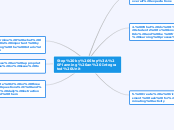Step by Step: Planning an Integrated Unit
3. Brainstorm possible activities based on the overall expectations
Educators must plan based around what they want students to know, do, and be in their learning journey
Mapping Activity- each students is assigned a specific province or territory in Canada. Each group is assigned to map the 10 metropolitan cities in each province or territory based on population. After mapping the ten largest metropolitan cities in each province or territory, students will determine if physical features shape or impact where people choose to live (mountain ranges, forest, tundra, climate, fertile soil etc...)
4. What do I want students to know, do and be from this learning process?
Expectations must be clustered into what an educator wants students to know (information acquired), do (skills), be (attitudes and beliefs)
KNOW: By the end of this unit, students are expected to be able to explain settlement patterns throughout Canada, and identify how specifically the physical environment shapes where people in Canada choose to live. Students will determine which provinces and territories are largest in size in relation to population, and will identify which specific physical features shape choice in where to settle in Canada.
DO: A1.1 Students will create their own guiding questions to investigate issues in Canadian geography
A1.2 Select and organize relevant data and
information on geographic issues from a
variety of primary and secondary sources
BE: Students will be more accommodating to diversity in Canada. Students will identify and explain the importance of diversity in climate and culture in Canada based on Canada's physical features.
Students will appreciate and understand climate and the diversity of Canada's culture, beliefs, and traditions based on climate
5. Create a rich assessment task for a culminating activity
Culminating Activity: Students will choose one specific climate
Assignment: Students will each be assigned with a specific in topic or guiding question and will create a visual report based on their guiding question.
Topic 1: How might a warmer
climate affect the skiing industry or the maple
syrup industry in southern Ontario or grain
farming on the Prairies?
Topic 2: How do environmental
changes affect plants and animals?
What are some plants and animals that are
now at risk or may become so because of
environmental changes?
Topic 3: How does a
change in permafrost affect transportation
and infrastructure?
Topic 4: What influence might
warmer temperatures and more frequent severe
storms have on high-density urban centres in
Canada?
Assessment: Students will have two primary assessments.
The first assessment is based on a peer assessment. Students will be given a word problem to assess their groups efforts. The group is given 1 000 000 dollars, and must divide it among the group based on the amount of effort that was provided. If the money is divided equally, it is evident each group member completed an equal amount of work.
Next, students will be assessed by a rubric that was co-created by educator and students in the backward design approach (prior to the unit).
1. Determine what learning is important by scanning the Ontario curriculum
Course exploring: CGC1D Issues in Canadian Geography
Determine how humans have impacted the physical environment in Canada, and how the physical environment has shaped where humans choose to live
What learning is important: Using geographic inquiry to investigate issues dealing with Canadian geography
Include lessons which are shaped around using everyday skills such as spatial technology skills, and identify some careers in which are shaped around the theme of geography
2. Choose an appropriate theme or issue to study
Strand B: Interactions in the Physical Environment
B1 The Physical Environment and Human Activities:
Analyse various interactions between physical processes,
phenomena, and events and human activities in Canada
6. Create 2 or three big questions, and organize daily instruction around them
Big question #1: How do the natural
characteristics of Canada
influence human activity,
and how might human
activity influence Canada’s
natural characteristics?
Big question #2: In what ways do Earth’s
natural processes,
phenomena, and events
influence Canada’s natural
characteristics?
Big question #3: In what ways is Canadian
identity tied to our natural
landscape?
